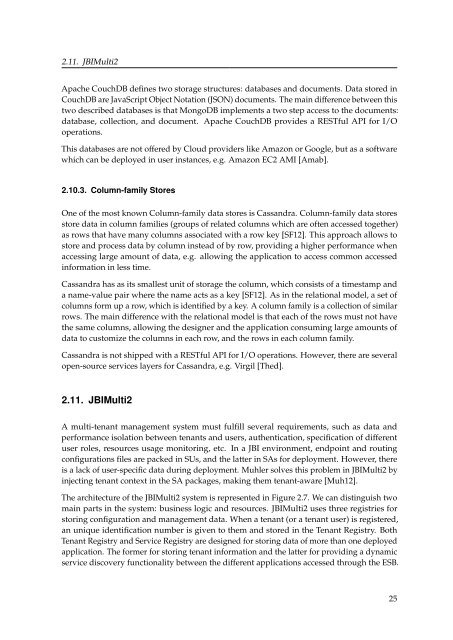Diploma Thesis Santiago Gómez Sáez - IAAS
Diploma Thesis Santiago Gómez Sáez - IAAS
Diploma Thesis Santiago Gómez Sáez - IAAS
Create successful ePaper yourself
Turn your PDF publications into a flip-book with our unique Google optimized e-Paper software.
2.11. JBIMulti2<br />
Apache CouchDB defines two storage structures: databases and documents. Data stored in<br />
CouchDB are JavaScript Object Notation (JSON) documents. The main difference between this<br />
two described databases is that MongoDB implements a two step access to the documents:<br />
database, collection, and document. Apache CouchDB provides a RESTful API for I/O<br />
operations.<br />
This databases are not offered by Cloud providers like Amazon or Google, but as a software<br />
which can be deployed in user instances, e.g. Amazon EC2 AMI [Amab].<br />
2.10.3. Column-family Stores<br />
One of the most known Column-family data stores is Cassandra. Column-family data stores<br />
store data in column families (groups of related columns which are often accessed together)<br />
as rows that have many columns associated with a row key [SF12]. This approach allows to<br />
store and process data by column instead of by row, providing a higher performance when<br />
accessing large amount of data, e.g. allowing the application to access common accessed<br />
information in less time.<br />
Cassandra has as its smallest unit of storage the column, which consists of a timestamp and<br />
a name-value pair where the name acts as a key [SF12]. As in the relational model, a set of<br />
columns form up a row, which is identified by a key. A column family is a collection of similar<br />
rows. The main difference with the relational model is that each of the rows must not have<br />
the same columns, allowing the designer and the application consuming large amounts of<br />
data to customize the columns in each row, and the rows in each column family.<br />
Cassandra is not shipped with a RESTful API for I/O operations. However, there are several<br />
open-source services layers for Cassandra, e.g. Virgil [Thed].<br />
2.11. JBIMulti2<br />
A multi-tenant management system must fulfill several requirements, such as data and<br />
performance isolation between tenants and users, authentication, specification of different<br />
user roles, resources usage monitoring, etc. In a JBI environment, endpoint and routing<br />
configurations files are packed in SUs, and the latter in SAs for deployment. However, there<br />
is a lack of user-specific data during deployment. Muhler solves this problem in JBIMulti2 by<br />
injecting tenant context in the SA packages, making them tenant-aware [Muh12].<br />
The architecture of the JBIMulti2 system is represented in Figure 2.7. We can distinguish two<br />
main parts in the system: business logic and resources. JBIMulti2 uses three registries for<br />
storing configuration and management data. When a tenant (or a tenant user) is registered,<br />
an unique identification number is given to them and stored in the Tenant Registry. Both<br />
Tenant Registry and Service Registry are designed for storing data of more than one deployed<br />
application. The former for storing tenant information and the latter for providing a dynamic<br />
service discovery functionality between the different applications accessed through the ESB.<br />
25

















